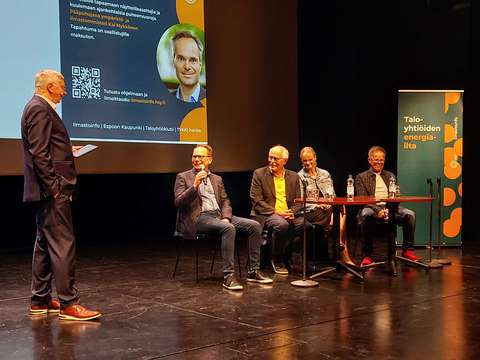The TYKKI project for developing collaboration between housing companies has ended – neighbourhood collaboration in Matinkylä continues

Between 2023 and 2024, Espoo’s Matinkylä has developed an operating model for neighbourhood collaboration between housing companies. The aim of the model is to support the low-carbon and systematic development of properties and to connect companies in the sector and the City of Espoo to the green transition of housing companies. The project, known as TYKKI, finished at the end of 2024.
During the project, board members from over 60 housing companies have participated in the housing company network. As part of the network's collaboration efforts, Matinkylä has continued to develop the pilot project of the Taloyhtiöklubi project(external link, opens in a new window), which was carried out in the Helsinki capital region between 2020 and 2021.
- Activities that support the networking of housing company boards have been tested and conceptualised. This includes the following networking events for housing companies: the Taloyhtiöiden yhteistyöilta event, the Taloyhtiöiden energiailta seminar and the mini fair. A multi-channel communications package supplemented by HSY’s Climateinfo and collaboration between local actors, with newsletters, surveys and discussion platforms, has been created to support the network's activities.
- The calculation of housing companies’ carbon footprints has been piloted by measuring the emissions of property management and waste transport in addition to heating emissions. The usability of housing companies’ energy certificates in the planning of energy saving measures for properties has been improved. The financial statements and maintenance costs of properties in the area have also been compared.
- The Liiteri.fi(external link, opens in a new window) leasing and lending container for goods has been piloted to promote the circular economy and energy efficiency and to support the networking of different actors.
- The Taloyhtiöverkostotoiminnan opas(external link, opens in a new window) (Guide to Housing Company Network Activities) guide was created to supplement the “Klubitoiminnan käsikirja” (Club Activity Handbook) guide of the sister project in Vantaa.
Kai Fogelholm, who was responsible for the project on the city’s end, highlights the partnership and communication with different actors as one achievement of the project.
“For example, the container trial has given us an opportunity to test the lending of equipment related to the accessibility of the city’s sports services through such a local service. On the other hand, we have made real contributions to culture together with active residents in the area by having volunteers attach two graffiti artworks to the sides of the container. The pieces were community artworks previously recovered during the demolition of the Matinkylä shopping centre,” Fogelholm says.
While project work has focused on establishing energy efficiency measures and collaboration between housing companies in the area, the network has extensively discussed the development needs and opportunities of properties, ranging from urban green spaces and parking to construction of new buildings and additions to existing buildings.
Kimmo Karvinen from Good House Oy, who developed the operating model during the project, points out that, similarly to property development, building collaboration between housing companies is a marathon, not a sprint.
“Activities will continue under Matinkylä's Taloyhtiöklubi, which everyone is welcome to join. Networking has already opened up huge opportunities in service acquisition, housing block-level collaboration and reducing housing company maintenance costs. Long-term efforts to address these themes will continue in Matinkylä,” Karvinen says.
“The low-carbon theme will continue to be important, because improving energy efficiency is the single most important development theme for housing companies,” he continues.
Getting housing companies and the housing sector involved in carbon neutrality work
Buildings amount for nearly 40 percent of Finland’s total energy consumption, and emissions from properties make up one-third of carbon dioxide emissions. More than 50,000 Espoo residents live in privately funded apartment buildings from the 1960s, 1970s and 1980s that are due for complete renovations. The housing companies’ boards are facing a major challenge in slowing down the increase of housing costs while reducing their properties’ carbon footprints and environmental burden. The similar characteristics and ages of the properties are also a strong argument for collaboration with other housing companies on carrying out repairs and issuing tenders.
“While we have been unable to persuade the property management sector, for example, of the beneficial effects of collaboration on their own work, we have still taken steps to develop an operating model,” says Fogelholm.
“In one way or another, housing companies must be included in the municipality’s sustainable development. Improving the energy efficiency of the current building stock is one of the potentially most effective ways in which environmental emissions can be reduced. At the same time, the repair backlog of properties has continued to grow. New ways of speeding up the energy efficiency measures of housing companies are needed. The boards and property managers of housing companies are key actors in this, and the municipality also has a role to play,” Fogelholm points out.
Kimmo Karvinen
CEO
Good House Oy
Tel. +358 (0)44 5045 952
kimmo.karvinen@goodhouse.fi
Kai Fogelholm
Project Manager
City of Espoo / Urban Environment Division, Housing Services
Tel. +358 (0)50 5539 006
kai.fogelholm@espoo.fi
The TYKKI project, which seeks solutions for the low-carbon development of suburbs, has received support from the Ministry of the Environment under the Low-carbon Built Environment Programme. Programme funding comes from the EU's temporary recovery instrument, the Recovery and Resilience Facility (RRF).